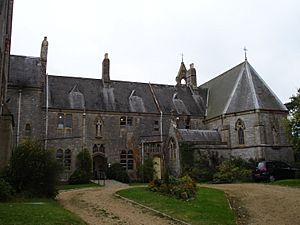Carisbrooke Priory facts for kids
Carisbrooke Priory was an old religious building on the Isle of Wight. It was like a branch office or a smaller part of a bigger abbey called Lyre Abbey in Normandy, France. This type of place was known as an "alien priory" because its main home was in another country. The priory was built on a hill near Carisbrooke, close to Newport.
Contents
History of the Priory
Early Monks: The Benedictines
The story of Carisbrooke Priory began in 1046. A man named William FitzOsbern, who was a relative of William the Conqueror, started Lyre Abbey in Normandy. When William the Conqueror became King of England, FitzOsbern was put in charge of the Isle of Wight. He lived at Carisbrooke Castle.
After the Normans took over England, FitzOsbern became a very powerful person. He owned a lot of land and gave many gifts to Lyre Abbey. Around 1067, the church in Carisbrooke and other properties were given to Lyre Abbey. By the mid-1100s, the monks at Lyre Abbey followed the Benedictine way of life, which is a set of rules for monks.
Around 1100, King Henry I of England made Richard de Redvers the Lord of the Isle of Wight. Richard's son, Baldwin de Redvers, also gave many churches, lands, and money he owned on the island to Lyre Abbey. King Henry II later confirmed these gifts.
Carisbrooke Priory itself was started in 1156 by Baldwin de Redvers. Its main job was to collect the payments and manage the properties that Lyre Abbey owned on the Isle of Wight. The monks living at Carisbrooke also helped out in the local churches of Newport and Northwood.
Times of War and Change
During wars between England and France, English kings sometimes took control of "alien priories" like Carisbrooke. This happened in 1295 when King Edward I of England was fighting France. The priory was taken by the Crown, which means the king's government.
It happened again during the time of King Edward III. Later, King Richard II gave the priory to a different group of monks, the Carthusians, at Mount Grace Priory in Yorkshire.
However, King Henry IV later gave Carisbrooke Priory back to its original prior (the head monk). But there was a condition: the usual payment that went to Lyre Abbey in France now had to go to the English king instead. Also, any new monks joining Carisbrooke had to be English.
Despite this, King Henry V seized the priory again. He gave it to his new religious house called Sheen Priory. At this point, the monks who lived at Carisbrooke were sent away.
New Beginnings: Dominican Nuns
Many years later, in the 1800s, the site of Carisbrooke Priory found a new purpose. Elizabeth Burrell, who was also known as Lady Clare, decided to help a group of Dominican nuns. These nuns were from Stoneyhurst, and Lady Clare invited them to move to the Isle of Wight in 1865.
Lady Clare gave a large sum of money, £12,000, to help build a new priory for the nuns at Carisbrooke. This new building was constructed on the very same spot where the old medieval priory had stood.
Interestingly, the Dominican nuns who moved to Carisbrooke had a long history. Their community had been started in the mid-1600s by Philip Howard, a Dominican friar. Their convent had first been in Flanders (now part of Belgium) before they moved to the Isle of Wight.
In April 1993, a group called the Carisbrooke Priory Trust bought the property. It had been home to a Catholic community of nuns since the new house was built in 1866.


